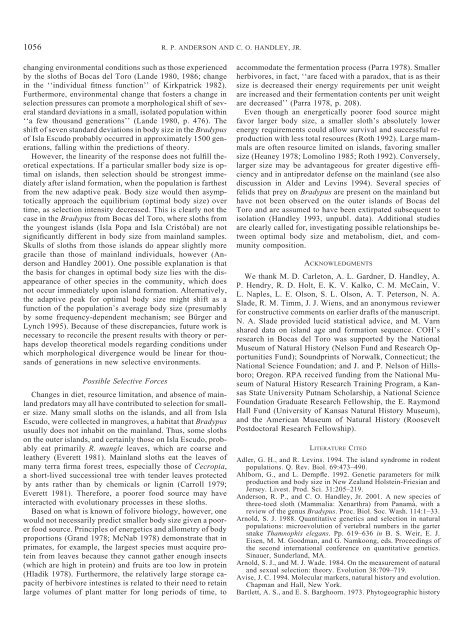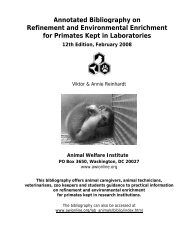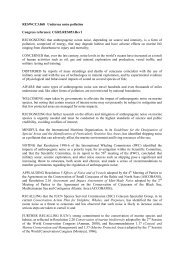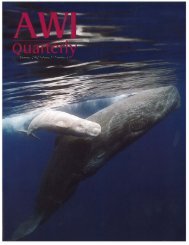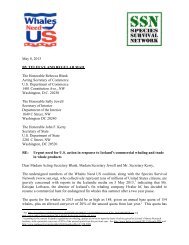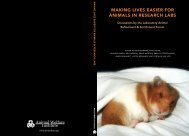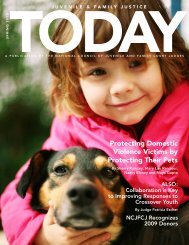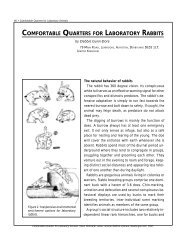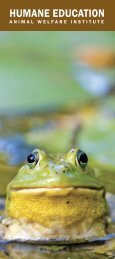1056 R. P. ANDERSON AND C. O. HANDLEY, JR.changing environmental conditions such as those experiencedby the sloths of Bocas del Toro (Lande 1980, 1986; changein the ‘‘individual fitness function’’ of Kirkpatrick 1982).Furthermore, environmental change that fosters a change inselection pressures can promote a morphological shift of severalstandard deviations in a small, isolated population within‘‘a few thousand generations’’ (Lande 1980, p. 476). Theshift of seven standard deviations in body size in the Bradypusof Isla Escudo probably occurred in approximately 1500 generations,falling within the predictions of theory.However, the linearity of the response does not fulfill theoreticalexpectations. If a particular smaller body size is optimalon islands, then selection should be strongest immediatelyafter island formation, when the population is farthestfrom the new adaptive peak. Body size would then asymptoticallyapproach the equilibrium (optimal body size) overtime, as selection intensity decreased. This is clearly not thecase in the Bradypus from Bocas del Toro, where sloths fromthe youngest islands (Isla Popa and Isla Cristóbal) are notsignificantly different in body size from mainland samples.Skulls of sloths from those islands do appear slightly moregracile than those of mainland individuals, however (Andersonand Handley 2001). One possible explanation is thatthe basis for changes in optimal body size lies with the disappearanceof other species in the community, which doesnot occur immediately upon island formation. Alternatively,the adaptive peak for optimal body size might shift as afunction of the population’s average body size (presumablyby some frequency-dependent mechanism; see Bürger andLynch 1995). Because of these discrepancies, future work isnecessary to reconcile the present results with theory or perhapsdevelop theoretical models regarding conditions underwhich morphological divergence would be linear for thousandsof generations in new selective environments.Possible Selective ForcesChanges in diet, resource limitation, and absence of mainlandpredators may all have contributed to selection for smallersize. Many small sloths on the islands, and all from IslaEscudo, were collected in mangroves, a habitat that Bradypususually does not inhabit on the mainland. Thus, some slothson the outer islands, and certainly those on Isla Escudo, probablyeat primarily R. mangle leaves, which are coarse andleathery (Everett 1981). Mainland sloths eat the leaves ofmany terra firma forest trees, especially those of Cecropia,a short-lived successional tree with tender leaves protectedby ants rather than by chemicals or lignin (Carroll 1979;Everett 1981). Therefore, a poorer food source may haveinteracted with evolutionary processes in these sloths.Based on what is known of folivore biology, however, onewould not necessarily predict smaller body size given a poorerfood source. Principles of energetics and allometry of bodyproportions (Grand 1978; McNab 1978) demonstrate that inprimates, for example, the largest species must acquire proteinfrom leaves because they cannot gather enough insects(which are high in protein) and fruits are too low in protein(Hladik 1978). Furthermore, the relatively large storage capacityof herbivore intestines is related to their need to retainlarge volumes of plant matter for long periods of time, toaccommodate the fermentation process (Parra 1978). Smallerherbivores, in fact, ‘‘are faced with a paradox, that is as theirsize is decreased their energy requirements per unit weightare increased and their fermentation contents per unit weightare decreased’’ (Parra 1978, p. 208).Even though an energetically poorer food source mightfavor larger body size, a smaller sloth’s absolutely lowerenergy requirements could allow survival and successful reproductionwith less total resources (Roth 1992). Large mammalsare often resource limited on islands, favoring smallersize (Heaney 1978; Lomolino 1985; Roth 1992). Conversely,larger size may be advantageous for greater digestive efficiencyand in antipredator defense on the mainland (see alsodiscussion in Alder and Levins 1994). Several species offelids that prey on Bradypus are present on the mainland buthave not been observed on the outer islands of Bocas delToro and are assumed to have been extirpated subsequent toisolation (Handley 1993, unpubl. data). Additional studiesare clearly called for, investigating possible relationships betweenoptimal body size and metabolism, diet, and communitycomposition.ACKNOWLEDGMENTSWe thank M. D. Carleton, A. L. Gardner, D. Handley, A.P. Hendry, R. D. Holt, E. K. V. Kalko, C. M. McCain, V.L. Naples, L. E. Olson, S. L. Olson, A. T. Peterson, N. A.Slade, R. M. Timm, J. J. Wiens, and an anonymous reviewerfor constructive comments on earlier drafts of the manuscript.N. A. Slade provided lucid statistical advice, and M. Varnshared data on island age and formation sequence. COH’sresearch in Bocas del Toro was supported by the NationalMuseum of Natural History (Nelson Fund and Research OpportunitiesFund); Soundprints of Norwalk, Connecticut; theNational Science Foundation; and J. and P. Nelson of Hillsboro;Oregon. RPA received funding from the National Museumof Natural History Research Training Program, a KansasState University Putnam Scholarship, a National ScienceFoundation Graduate Research Fellowship, the E. RaymondHall Fund (University of Kansas Natural History Museum),and the American Museum of Natural History (RooseveltPostdoctoral Research Fellowship).LITERATURE CITEDAdler, G. H., and R. Levins. 1994. The island syndrome in rodentpopulations. Q. Rev. Biol. 69:473–490.Ahlborn, G., and L. Dempfle. 1992. Genetic parameters for milkproduction and body size in New Zealand Holstein-Friesian andJersey. Livest. Prod. Sci. 31:205–219.Anderson, R. P., and C. O. Handley, Jr. 2001. A new species ofthree-toed sloth (Mammalia: Xenarthra) from Panamá, with areview of the genus Bradypus. Proc. Biol. Soc. Wash. 114:1–33.Arnold, S. J. 1988. Quantitative genetics and selection in naturalpopulations: microevolution of vertebral numbers in the gartersnake Thamnophis elegans. Pp. 619–636 in B. S. Weir, E. J.Eisen, M. M. Goodman, and G. Namkoong, eds. Proceedings ofthe second international conference on quantitative genetics.Sinauer, Sunderland, MA.Arnold, S. J., and M. J. Wade. 1984. On the measurement of naturaland sexual selection: theory. Evolution 38:709–719.Avise, J. C. 1994. Molecular markers, natural history and evolution.Chapman and Hall, New York.Bartlett, A. S., and E. S. Barghoorn. 1973. Phytogeographic history
DWARFISM IN INSULAR <strong>SLOTH</strong>S1057of the Isthmus of Panama during the past 12,000 years (a historyof vegetation, climate, and sea-level change). Pp. 203–299 in A.Graham, ed. Vegetation and vegetational history of northernLatin America. Elsevier, New York.Beebe, W. 1926. The three-toed sloth Bradypus cuculliger cuculligerWagler. Zoologica 7:1–67.Beniwal, B. K., I. M. Hastings, R. Thompson, and W. G. Hill. 1992.Estimation of changes in genetic parameters in selected lines ofmice using REML with an animal model. 1. Lean mass. Heredity69:352–360.Brattstrom, B. H. 1966. Sloth behavior. J. Mammal. 47:348.Britton, S. W., and W. E. Atkinson. 1938. Poikilothermism in thesloth. J. Mammal. 19:94–99.Britton, S. W., and R. F. Kline. 1939. On deslothing the sloth.Science 90:16–17.Brooks, D. R., and D. A. McLennan. 1991. Phylogeny, ecology,and behavior: a research program in comparative biology. Univ.of Chicago Press, Chicago, IL.Brown, J. H., and M. L. Lomolino. 1998. Biogeography. 2d ed.Sinauer, Sunderland, MA.Brown, J. H., P. A. Marquet, and M. L. Taper. 1993. Evolution ofbody size: consequences of an energetic definition of fitness.Am. Nat. 142:573–584.Bürger, R., and M. Lynch. 1995. Evolution and extinction in achanging environment: a quantitative-genetic analysis. Evolution49:151–163.Carroll, C. R. 1979. A comparative study of two ant faunas: thestem-nesting ant communities of Liberia, West Africa and CostaRica, Central America. Am. Nat. 113:551–561.Carvalho, C. T. 1960. Notes on the three-toed sloth, Bradypus tridactylus.Mammalia 24:155–156.Case, T. J. 1978. A general explanation for insular body size trendsin terrestrial vertebrates. Ecology 59:1–18.Case, T. J., and T. D. Schwaner. 1993. Island/mainland body sizedifferences in Australian varanid lizards. Oecologia 94:102–109.Chiarello, A. G. 1998a. Activity budgets and ranging patterns ofthe Atlantic forest maned sloth Bradypus torquatus (Xenarthra:Bradypodidae). J. Zool. 246:1–10.———. 1998b. Diet of the Atlantic forest maned sloth Bradypustorquatus (Xenarthra: Bradypodidae). J. Zool. 246:11–19.Colinvaux, P. 1997. The history of forests on the isthmus from theIce Age to the present. Pp. 123–136 in A. G. Coates, ed. CentralAmerica: a natural and cultural history. Yale Univ. Press, NewHaven, CT.Crowell, K. L. 1983. Islands—insight or artifact?: Population dynamicsand habitat utilization in insular rodents. Oikos 41:442–454.Darwin, C. 1859. The origin of species by means of natural selection;or the preservation of favored races in the struggle for life.Murray, London.Draper, N. R., and H. Smith. 1981. Applied regression analysis. 2ded. John Wiley and Sons, New York.Endler, J. A. 1986. Natural selection in the wild. Princeton Univ.Press, Princeton, NJ.Everett, T. H. 1981. The New York Botanical Garden illustratedencyclopedia of horticulture. Garland, New York.Fairbanks, R. G. 1989. A 17,000-year glacio-eustatic sea level record:influence of glacial melting rates on the Younger Dryosevent and deep-ocean circulation. Nature 342:637–642.Felsenstein, J. 1985. Phylogenies and the comparative method. Am.Nat. 125:1–15.Foster, J. B. 1964. Evolution of mammals on islands. Nature 202:234–235.Futuyma, D. J. 1998. Evolutionary biology. 3rd ed. Sinauer, Sunderland,MA.García-París, M., and D. B. Wake. 2000. Molecular phylogeneticanalysis of relationships of the tropical salamander genera Oedipinaand Nototriton, with descriptions of a new genus and threenew species. Copeia 2000:42–70.Gardner, A. L. 1993. Order Xenarthra. Pp. 63–68 in D. E. Wilsonand D. M. Reeder, eds. Mammal species of the world: a taxonomicand geographic reference. 2d ed. Smithsonian InstitutionPress, Washington, D.C.Gingerich, P. D. 1983. Rates of evolution: effects of time and temporalscaling. Science 222:159–161.———. 1993. Quantification and comparison of evolutionary rates.Am. J. Sci. 293A:453–478.———. 1994. Rates of evolution in the dentition of early EoceneCantius: comparison of size and shape. Paleobiology 20:506–522.———. 2001. Rates of evolution on the time scale of the evolutionaryprocess. Genetica 112/113:127–144.Grand, T. I. 1978. Adaptations of tissue and limb segments to facilitatemoving and feeding in arboreal folivores. Pp. 231–241in G. G. Montgomery, ed. The ecology of arboreal folivores.Smithsonian Institution Press, Washington, D.C.Grant, P. R. 1986. Ecology and evolution of Darwin’s finches.Princeton Univ. Press, Princeton, NJ.Haldane, J. B. S. 1949. Suggestions as to the quantitative measurementof rates of evolution. Evolution 3:51–56.Handley, C. O., Jr. 1959. A review of the genus Hoplomys (thickspinedrats), with description of a new form from Isla Escudode Veraguas, Panama. Smithson. Misc. Collect. 139:1–10.———. 1993. Conservación de la fauna y la flora en las islas deBocas del Toro. Pp. 43–48 in S. Heckadon-Moreno, ed. Agendaecológica y social para Bocas del Toro. Paseo Pantera and SmithsonianTropical Research Institute, Panama City.Hartl, D. L., and A. G. Clark. 1989. Principles of population genetics.2d ed. Sinauer, Sunderland, MA.Hayssen, V., A. van Tienhoven, and A. van Tienhoven. 1993. Asdell’spatterns of mammalian reproduction: a compendium ofspecies-specific data. Cornell Univ. Press, Ithaca, NY.Heaney, L. R. 1978. Island area and body size of insular mammals:evidence from the tri-colored squirrel (Callosciurus prevosti) ofSoutheast Asia. Evolution 32:29–44.———. 1986. Biogeography of mammals in SE Asia: estimates ofrates of colonization, extinction, and speciation. Biol. J. Linn.Soc. 28:127–165.———. 2000. Dynamic disequilibrium: a long-term, large-scaleperspective on the equilibrium model of island biogeography.Global Ecol. Biogeogr. 9:59–74.Hendry, A. P., and M. T. Kinnison. 1999. The pace of modern life:measuring rates of contemporary microevolution. Evolution 53:1637–1653.Hladik, C. M. 1978. Adaptive strategies of primates in relation toleaf-eating. Pp. 373–395 in G. G. Montgomery, ed. The ecologyof arboreal folivores. Smithsonian Institution Press, Washington,D.C.Hoekstra, H. E., J. M. Hoekstra, D. Berrigan, S. N. Vignieri, A.Hoang, C. E. Hill, P. Beerli, and J. G. Kingsolver. 2001. Strengthand tempo of directional selection in the wild. Proc. Natl. Acad.Sci. USA 98:9157–9160.Kalko, E. K. V., and C. O. Handley, Jr. 1994. Evolution, biogeography,and description of a new species of fruit-eating bat,genus Artibeus Leach (1821) from Panama. Z. Saeugetierkd. 59:257–273.Kingsolver, J. G., H. E. Hoekstra, J. M. Hoekstra, D. Berrigan, S.N. Vignieri, C. E. Hill, A. Hoanag, P. Gibert, and P. Beerli.2001. The strength of phenotypic selection in natural populations.Am. Nat. 157:245–261.Kinnison, M. T., and A. P. Hendry. 2001. The pace of modern lifeII: from rates of contemporary microevolution to pattern andprocess. Genetica 112/113:145–164.Kirkpatrick, M. 1982. Quantum evolution and punctuated equilibriain continuous genetic characters. Am. Nat. 119:833–848.Lande, R. 1977. Statistical tests for natural selection on quantitativecharacters. Evolution 31:442–444.———. 1979. Quantitative genetic analysis of multivariate evolution,applied to brain:body size allometry. Evolution 33:402–416.———. 1980. Genetic variation and phenotypic evolution duringallopatric speciation. Am. Nat. 116:463–479.———. 1986. The dynamics of peak shifts and the pattern of morphologicalevolution. Paleobiology 12:343–354.Lawlor, T. E. 1982. The evolution of body size in mammals: evidencefrom insular populations in Mexico. Am. Nat. 119:54–72.
- Page 1 and 2: EMERGENCY PETITION TO LIST THEPYGMY
- Page 3 and 4: NOTICE OF PETITIONAnimal Welfare In
- Page 5 and 6: I. NATURAL HISTORY AND STATUS OF TH
- Page 7 and 8: known to occur, is estimated to be
- Page 9 and 10: 3. Population Trend and Extinction
- Page 11 and 12: An emergency ESA listing of the pyg
- Page 13 and 14: If not immediately protected under
- Page 15 and 16: very small island off the coast of
- Page 17 and 18: LITERATURE CITEDAnderson RP and Han
- Page 19 and 20: Evolution, 56(5), 2002, pp. 1045-10
- Page 21 and 22: DWARFISM IN INSULAR SLOTHS1047FIG.
- Page 23 and 24: DWARFISM IN INSULAR SLOTHS1049Cayo
- Page 25 and 26: DWARFISM IN INSULAR SLOTHS1051There
- Page 27 and 28: DWARFISM IN INSULAR SLOTHS1053showe
- Page 29: DWARFISM IN INSULAR SLOTHS1055shoul
- Page 33 and 34: IB4/inPROCEEDINGS oi TilBTDLOGICALS
- Page 35 and 36: MAT (J 200 j } ) PROCEEDINGS OF THE
- Page 38 and 39: PROCEEDINGS OF THE BIOLOGICAL SOCIE
- Page 40 and 41: —PROCEEDINGS OF THE BIOLOGICAL SO
- Page 42 and 43: PROCEEDINGS OF THE BIOLOGICAL SOCIE
- Page 44 and 45: variegatus.Creteiationsabbrevharact
- Page 47 and 48: 1 1IIIIIIIIII',I':IIT•I'I'VOLUME
- Page 49 and 50: VOLUME 1 14, NUMBER 1 15Colon, and
- Page 51 and 52: —VOLUME 1 14, NUMBER 1 17Table 4.
- Page 53 and 54: VOLUME 1 14, NUMBER 1 19Table 5.—
- Page 55 and 56: —VOLUME 114. NUMBER 1 2185°Brady
- Page 57 and 58: VOLUME 114, NUMBER 1 23Bradypus var
- Page 59 and 60: —VOLUME 1 14, NUMBER 1 25of B. va
- Page 61 and 62: Observations on the Endemic Pygmy T
- Page 63 and 64: Observations of Bradypus pygmaeusTa
- Page 65 and 66: 2013.1Login | FAQ | Contact | Terms
- Page 67 and 68: The 2010 Sloth Red List AssessmentA
- Page 69 and 70: 65Number of Species43210TaxonomyPop
- Page 71 and 72: Figure 3. Bradypus pygmaeus. Based
- Page 73 and 74: Park), among other areas, although
- Page 75 and 76: Bradypus tridactylusLeast Concern (
- Page 77 and 78: Bradypus variegatusLeast Concern (L
- Page 79 and 80: Figure 6. Bradypus variegatus. Base
- Page 81 and 82:
Figure 7. Choloepus didactylus. Bas
- Page 83 and 84:
as well as in secondary forest, but
- Page 85 and 86:
Acknowledgements: This assessment w
- Page 87 and 88:
perezoso de dos uñas (Choloepus ho
- Page 89 and 90:
2 MAMMALIAN SPECIES 812—Bradypus
- Page 91:
4 MAMMALIAN SPECIES 812—Bradypus
- Page 109 and 110:
J Etholtemporal frequency of vocali
- Page 111 and 112:
J EtholTable 1 Inferred period (thi
- Page 113 and 114:
J EtholB. variegatus males seem to
- Page 115 and 116:
http://news.mongabay.com/2013/0920-
- Page 117 and 118:
Crates with pygmy sloths destined f
- Page 119 and 120:
LEFT: Pygmy sloth in a box back on
- Page 121 and 122:
elevant stakeholders. A serious con
- Page 123 and 124:
night amidst violent social unrest,
- Page 125 and 126:
How Did Dallas Aquarium Almost Get
- Page 127:
three-toed sloth becomes a CITES II
- Page 132 and 133:
Although Aviarios del Caribe claims
- Page 134 and 135:
Ms. Cliffe cite hunting pressure fr
- Page 136 and 137:
work being conducted by our interna


